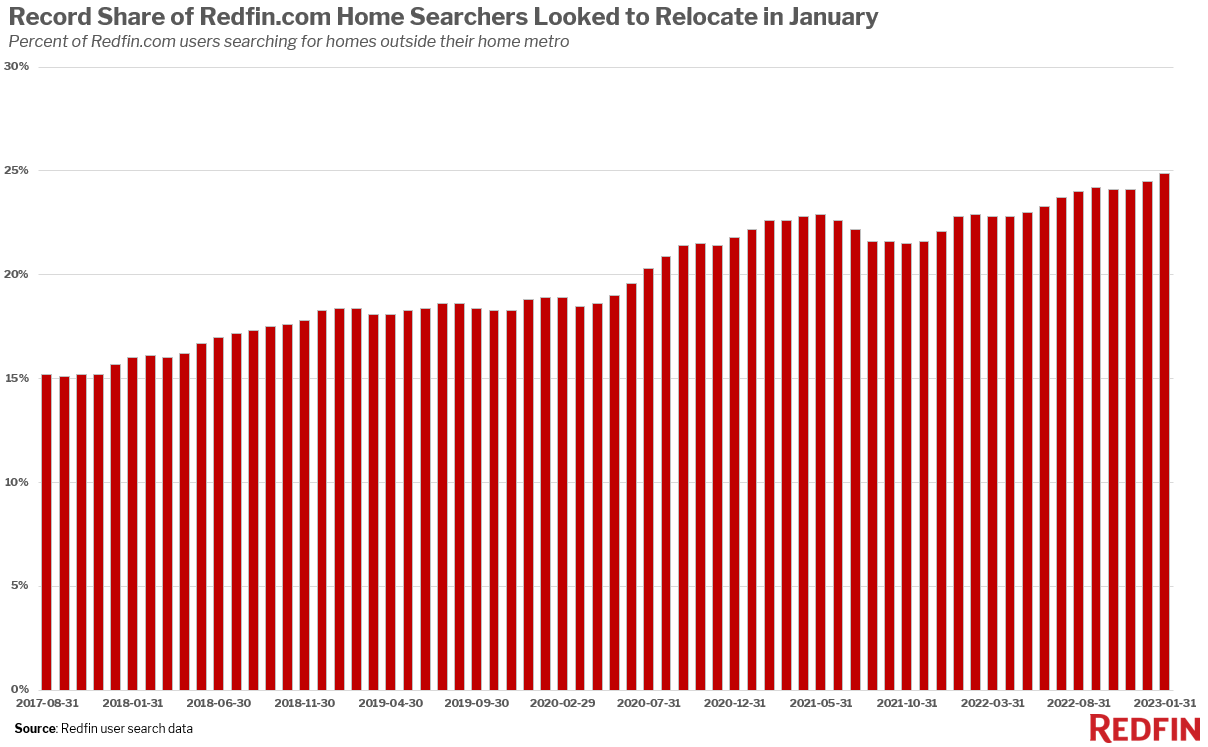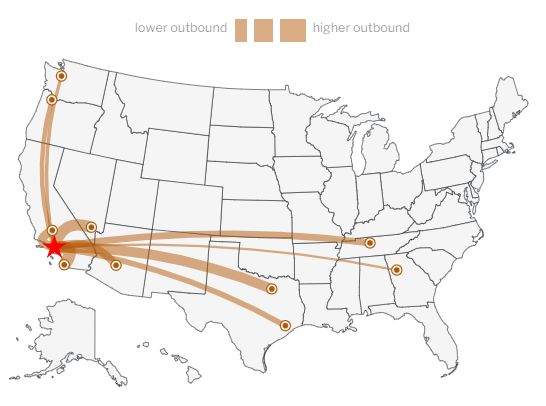A record one-quarter (24.9%) of Redfin.com users nationwide looked to move to a different metro area in January as remote work and elevated housing costs drove homebuyers to relocate.
That’s up from 24.5% in Q4, 22.8% a year ago and roughly 18% before the pandemic.
High mortgage rates have caused many would-be homebuyers to back out of the market, with overall U.S. home sales down considerably from a year ago. But among the people who are buying homes, a record portion are relocating largely due to the ongoing affordability crisis.
The typical monthly housing payment is 26% higher than it was in the beginning of 2022. That’s because mortgage rates remain near the 20-year high hit in November and home prices are still up from a year ago despite the cooling market.

High housing costs–along with the rising price of other goods and services due to inflation–make relatively affordable destinations attractive, especially for remote workers with the flexibility to relocate. While home prices soared last year in many popular migration destinations like Sacramento and Phoenix, those places are now among those where prices are dropping fastest. Plus, they’re much more affordable than the places people are leaving. Los Angeles, where the typical home sells for about $800,000, was the most common origin for homebuyers moving to Las Vegas and Dallas, both popular destinations where the typical home sells for roughly half of that.
Miami reclaims status as top migration hotspot
Miami was the most popular migration destination in January, claiming the top spot for the first time since August. Popularity is determined by net inflow, a measure of how many more Redfin.com users are looking to move into an area than leave. Half of the 10 most popular destinations are in Florida: Tampa, Cape Coral, Orlando and North Port-Sarasota are also on the list.
Homes in Florida certainly aren’t cheap; the typical Miami home sold for $470,000 in January, compared with the $383,000 national median. But they do tend to be less expensive than the places people are coming from. The typical home in New York, the top origin for homebuyers relocating to Miami, sold for $650,000 in January. Plus, Florida’s overall cost of living is lower because it doesn’t have a state income tax.
“A lot of buyers have flocked into coastal Florida from out of town over the last several months,” said Elena Fleck, a Redfin agent in Palm Beach, which is part of the larger Miami metro area. “Buyers moving in from places like New York and San Francisco are helping the local market recover from last fall’s housing downturn. They’re not nearly as fazed by high mortgage rates because homes here are so much less expensive than their hometowns, and they get larger lots, pools, nice weather and lower taxes.”

After Miami, Sacramento, Las Vegas and Phoenix were the most popular destinations. Those are all mainstays on the migration hotspot list because, like Florida, buyers moving in from expensive coastal cities can find bigger homes for less money in warm climates. The typical home in eight of the 10 most popular destinations is less expensive than the typical home in the most common origin.
But fewer Redfin.com users looked to move to eight of the 10 most popular destinations than a year earlier, a shift that’s due to overall homebuying demand coming down from its high.
Homebuyers are leaving coastal California more than anywhere else
More homebuyers looked to leave San Francisco and Los Angeles than any other U.S. metro in January. Next come New York, Washington, D.C., Chicago and several other major cities. This ranking is determined by net outflow, a measure of how many more people are looking to leave a metro than move in.
Expensive coastal areas are perennially on the list of places people are looking to leave, a trend that has been exacerbated by remote work.
There are fewer homebuyers leaving most of those places than a year earlier, reflecting the slow housing market. The net outflow from seven of the top 10 metros was smaller in the fourth quarter than a year earlier. The slowdown was especially pronounced in Seattle, which had a net outflow of roughly 3,400 in January, down from 19,000 a year earlier.
To read the full report, including more data, charts and methodology, click here.

 theMReport.com Your trusted source for mortgage banking news
theMReport.com Your trusted source for mortgage banking news








